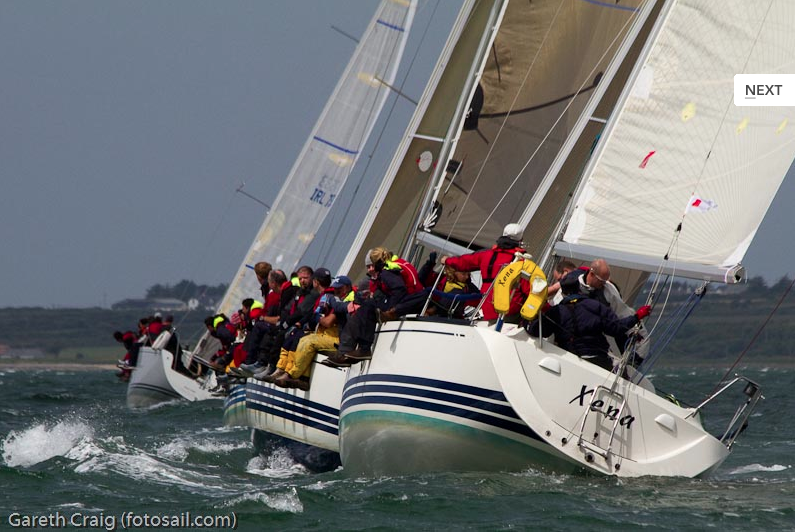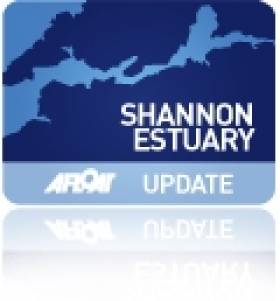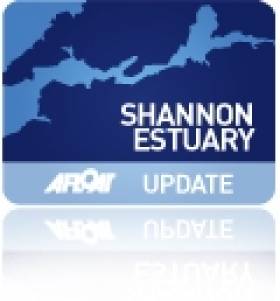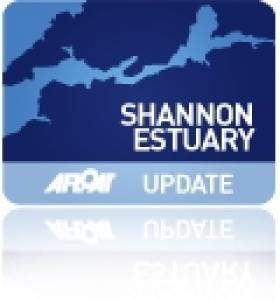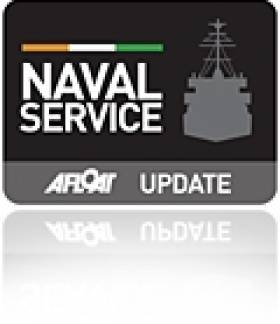Displaying items by tag: Shannon Estuary
Dempsey Declared Mermaid Champion with Race to Spare
Jonathan O'Rourke's No.77 Tiller Girl won today, leading the fleet the for the first half and then tussling with No 187 Zuleika for the 2nd half, eventually winning out on the last beat. There was considerable place swapping further down in the fleet. Of particular interest is the four McCormack boats competing for the Munster trophy. Brothers James and Vincent, and James' sons Darragh and Mark are competing in their four Mermaids and all in the running for the Munster trophy (9 boats eligible). They went around the 2nd leeward mark in a raft today, though without troubling the protest committee. It looks like it will be down to the last beat on the last day (tomorrow, Race 6).
The new unofficial champion has previously won Mermaid Week in 1987 and again in 2000, sailing his own boat No. 36 Elizabeth. Paul Winter's boat, No. 183 Wannago has won Mermaid Week once before, in Fenit in 2002, helmed by her builder and former owner Sam Shiels.
The unofficial winner of the Daphne (Silver fleet, 12 boats) was Geraldine O'Neill in 73 Lively Lady crewed by her husband Mick Hanney (President of Mermaid Sailing Association) and Ailbhe Smith. O'Neill, like Dempsey doesn't have to sail tomorrow to secure the trophy.
The Designer (Bronze fleet, 23 boats), unlike the others will be down to the bitter end with Mark McCormack (54 Hycilla) and Paddy Archer (18 Clare)being the main contenders.
All of the above is provisional information as Protest Time is still open for Race 5 until 20:41 this evening and overall championship results will not be confirmed officially until after 17:00 on Friday 6th August.
For the first time this year, the Mermaid Sailing Association and Foynes Yacht Club have been running a live blog during racing with updates every few minutes from the committee boat, supported by analysis from the race office. Live photos are also posted on the blog, including contentious start lines and boat on boat action. In today's racing over there were over 700 views of the blog and more than 100 on line at www.dublinbaymermaid.org/foynes2010 <http://www.dublinbaymermaid.org/foynes2010> simultaneously.
Mermaid Week concludes tomorrow with Race 6. 33 boats are competing. Follow the Live Commentary at for news of any protest this evening and during racing tomorrow from 13:00.
Racing Continues Apace at Mermaid Week
Race 3 of the National Mermaid Championship starts today at 15:00, followed by the annual 'crew' race. Five times champion Derek Joyce in 187 Zuleika has a major challenge to stay in the running and really needs a win to stay in contention. The stiffer breezes foretasted today should suit him. Another boat with some work to do is 131 Wild Wind, sailed by last year's champion Paddy Dillon; as he is lying third overall at seven points, he needs to stay in the top three today.
Yesterday's winner, Shay O'Toole (182 Dolphin) is lying 6th overall and another win today could put him in contention for the Championship. Current overall leader Jim Dempsey (183 Wannago), with two seconds under his belt, needs to maintain consistency as four times champion Jim Carthy (123 Vee) is hot on his heels just one point behind.
Of the 186 Mermaids built since 1932, some have been built by professionals and some by amateurs. Amateur is, perhaps not the best word as many Mermaid sailors are carpenters, furniture makers and woodwork teachers by profession and have build fast boats to exacting standards. The most prolific builders over the years have been John Brennan of Dun Laoghaire (16 boats), James Kearney (15 boats) and Skee Gray (10 boats).
Of the thirty three boats competing this week, Brennan built three, Harry & Tom Grieves built three and Des Tyrell built three. Four sailors are on board boats they built themselves: Frankie Browne (135 Cara II), Martin O'Toole (179 Bean Adhmaid), Shay O'Toole (182 Dolphin) and Ross Galbraith (185 The Message). Former champion Joe Boylan built the boats being sailed by his son Aidan (138 Zeila) and grandson Mark (177 This Is It).
If there was a Formula 1 style 'Constructor's Championship', the top three builders since 1953 would be: Harry & Tom Grieves, 9 wins; John Brennan, 8 wins and Des Tyrell, 7 wins. This year the Grieves boats are 73 Lively Lady, 76 Helen and 77 Tiller Girl. The Brennan boats are 131 Wild Wind, 143 Jill and 146 Fugitive, while the Tyrell boats are 186 MyDi, 187 Zuleika and 188 Innocence. It's all to play for.
Live updates will be blogged from the race area today at http://www.dublinbaymermaid.org/foynes2010/index_files/Commentary.htm.
Zuleika Dominates Second Race of Mermaid Week
Yesterday (Monday), Foynes lived up to it's reputation as being a tricky place in which to sail. A strong ebbing tide and shifty 8-10 knot breeze dominated racing in the 33 strong Mermaid fleet in Race 2 of the National Championship.
Race Officer, Liam Dineen, conscious of the effect of the tide sweeping across the start line opted to fly flag I instead of P at 4 minutes before start. This meant that any boats over the line in the last minute, had to go around either end of the start line before starting. The tide swept some boats over, and an individual recall was sounded, but no boats came back to restart.
Five times champion Derek Joyce in 187 Zuleika totally dominated the race, leading all the way and crossing the finish line in first place, to the sound of silence – he scored OCS as he was one of six boats over the line. Shay O'Toole's 182 Dolphin crossed one minute later and scored a first place, with Jim Dempsey in 183 Wannago in third place. Next to cross the line was Ross Galbraith in 185 The Message, but he also scored OCS. Wild Wind 131 (Paddy Dillon) was third, Vee 123 (Jim Carthy) was fourth. Enda Weldon in 186 MyDi crossed next but scored OCS, giving fifth place to Anthony Carthy in 188 Innocence. In the beats today it generally paid to go right, thus getting into the channel and riding the 1.9knot ebbing tide. There was a lot of place swapping on the last beat as the wind shifted NW, punishing those on the lay line.
This now leaves the championship wide open. One discard will apply once five races have been sailed and this leaves Championship contender Joyce with a hill to climb.
Overall placing after two races: 1st 183 Wannago (Dempsey) 4 points, 2nd 123 Vee (J Carthy) 5 points, 3rd 131 Wild Wind (Dillon), 7 points, 4th 188 Innocence (A Carthy) 10 points, 5th 135 Cara II (F Browne) 11 points. Today's winner, 182 Dolphin (S O'Toole) is 6th overall on equal points with 7th place 134 Jill (Smith). The remainder of the top 10 are 177 This is It, 73 Lively Lady and 77 Tiller Girl. Joyce is 18th with 40 points and is waiting for that discard to apply.
In the Daphne fleet (equivalent of Silver fleet), Geraldine O'Neill in 73 Lively Lady leads at 4 points, Paddy Boardman in 26 Thumbalina and Martin O'Toole in 179 Bean Adhmaid are next with 7 points each. In the Designer fleet (equivalent of Bronze), the leader is Mark Boylan in 177 This Is It with two wins, followed by Mark McCormack in 54 Hycilla and Paddy Archer in 18 Clare.
The first Mermaid was built in 1932 and new boats are currently under construction this year. The average age of the thirty three boats racing this week is 42.2 years.
Racing continues today, Tuesday, at 15:00, followed by the Crew Race at approximately 17:30. A Live Commentary is streamed on the web at www.dublinbaymermaid.org/foynes2010 (click on Commentary), and yesterday's commentary was viewed 435 by Mermaiders, retired sailors, family and friends all over the world. Today's Live Commentary will start at 14:30 and will continue till the end of the Crew Race at about 19:15.
Carthy Wins Opening Race of Mermaid Week
All age groups are sailing from pre-teen to some in their eighties. There are five pairs for brothers helming ten competing boats - Enda and Anthony Weldon from Rush, James and Vincent McCormack from Foynes, James's sons Darragh and Mark McCormack, Jim and Anthony Carthy from Rush and veterans Shay and Martin O'Toole from Skerries. There are also many husband/wife crews.
Frankie Browne of Skerries in Cara II (No. 135) got a great start and built on his lead during the first beat and again on the first run. He lead for the first eight legs, but on the ninth and last leg he failed to cover effectively and was beaten by Jim Carthy in No. 123 Vee (Rush) in 1st and Jim Dempsey in No. 183 Wannago (Skerries).
The 2009 Champion, Paddy Dillon (131 Wild Wind, Rush) was a solid fourth, with Anthony Carthy (188 Innocence, Rush) in fifth. Derek Joyce (187 Zuleika, Wexford) who had been in the top three also lost out on the last beat and came in sixth.
The winner of the "Daphne" fleet (equivalent of Silver Fleet) was Alan Berg of Rush, sailing No 93 Swallow. The winner of the "Designer" fleet was Mark Boylan in No. 177 This Is It, sailing a boat his father Joe built and sailed for many years. Best local boat was Vincent McCormack in No 119 Three Chevrons.
Racing today starts at 10:30 with live updates on the Mermaid Week website http://www.dublinbaymermaid.org/foynes2010/index_files/Commentary.htm.
Mermaid Week Starts with Fresh Conditions in Foynes
Local boat 46 Argo sailed by Darragh McCormack, Donal Moroney and Luke Murray were a convincing fourth and are showing a turn of speed, rewarding their practice in the past few months and work on the boat last winter. The 2009 champion 131 Wild Wind sailed by Paddy Dillon of Rush, retired early in the race.
There were three capsizes and some minor gear damage as the squalls came through past Foynes Island. Principal Race Officer Liam Dineen of Skerries set up a balanced course, with boats going up both sides of the beat, a slightly tight first reach and a square run.
The real racing starts tomorrow with Race 1 at 14:00.
Catch up with the latest Mermaid Week news and live updates during racing at www.dublinbaymermaid.org/foynes2010
Foynes Prepares to Stage Mermaid Week
Foynes Yacht Club on the Shannon Estuary is hosting the National Mermaid Championships, which will commence on Saturday, July 31, and which will be taking place for a full week at Cooleen Point.
Quite an amount of preparation and organisation is taking place to ensure that it will be one of the most successful championships to date.
Entries are expected to exceed 40 boats that will compete in the championship's. These boats are a classic 1932 design from all corners of Ireland, which will be racing daily for seven days on the majestic Shannon Estuary waters to the picturesque and historic port village of Foynes.
The competition brings with it a festival atmosphere, as over 150 sailors with their families and friends settle in for a week packed, competitive and social activities by day and night.
An action-packed programme of events will take place during the championships 'off the water', and this will commence on Saturday, July 31 with Karaoke; on Sunday, August 1 music will be provided by 'Motive'.
On Monday, August 2 a 'Family Fun Day' in Cooleen Point will take place, and this will feature a fundraising family fun, and games in aid of the Royal National Lifeboat Institution.
Besides such activities as a Bouncy Castle, Bar-B-Que, Karaoke and many more events, and the first ever sponsored Mud Splat Obstacle Course race, which will make very entertaining viewing.
And an added spectacle on Monday an air display from the Coastguard Helicopter based in Shannon, Co. Clare will take place.
A quiz night will take place on Tuesday, August 3, and on Wednesday, August 4, a Traditional music session will take place; on Thursday, August 5 a Comedy night is organised.
The Royal National Lifeboat Institution has saved more than 139,000 lives since its foundation in 1824. Through the years, there have been countless stories of courage against a background of technological developments and social change.
The charity was founded as the national institution for the preservation of life from shipwreck after an appeal was made by Sir William Hillary. Hillary lived in Douglas on the Isle of Man, and had witnessed the wrecking of dozens of ships from his home.
The name was changed to the Royal National Lifeboat Institution in 1854, and cork lifejackets were first issued to crew members in the same year.
In 1891, the first RNLI street collection was held in Manchester, and the 20th century saw the RNLI continue to save lives through two world wars.
The lifeboats moved from sail and oar power to petrol and diesel, and the first women joined their crews.
Recent years have seen major develpments with the introduction of RNLI lifeguards in 2001, and the first lifeboat station on an inland water in the same year.
There are 43 RNLI lifeboat stations in Ireland, where the nearest to Foynes is in Kilrush. The money raised from Mermaid week for the RNLI will be put to good use by RNLI personnel, where it will fund new equipment including lifeboats, seafaring wear, lifejackets and much more.
Foynes Yacht Club, Commodore Tom Murray is making a special appeal to all Mermaid sailors, club members and friends to come to the club and support this very worthy cause. 'The RNLI relies on the support of all the sailing and yacht clubs in the country for donations to keep this very important sea rescue operation running', he said.
Crew and assistance for crash boats will be wanted for the championships, so any member, who is interested in sailing or would like to help in the running of the championships are asked to please contact Commodore Tom Murray on 087 2563515; Mermaid Class Captain, Conor Roche on 086 8030343 or Cruiser Class Captain, Alan McEneff on 086 2568280 immediately.
The club website is www.foynesyachtclub.com
The West of Ireland Offshore Racing Association (WIORA), 'West Coast Championships' concluded at the weekend, which was hosted by the Royal Western Yacht Club based in Kilrush Co. Clare.
Strong winds prevailed thought the event and unfortunately no sailing took place on Friday due to the extreme wind conditions, but international race officer Alan Crosbie and his team did an excellent job in getting six races completed for each of the four classes; On the last day, race management was conducted from the Navel Ship the LE Aoife making a visit to Kilrush and adding greatly to the spectacle afloat. Photos on the gallery here.
Numbers may have be back on previous years but what was lacking in numbers was made up for by the standard and competiveness of the racing in each of the classes, so much so that in Class 2 it went to the wire on the final race of the final day to decide the overall placing in the Class with the order they finished in deciding the order of the class overall's.
In these economic times without the huge support of partners, events like this Regional Event could not be staged and with alot of help from Kilrush Credit Union / Kilrush Creek Marina / Shannon Development / Dubarry Ireland / Kilrush Chamber of Commerce / ropelocker.ie / fotosail.com / afloat.ie and the many local business made sure this was a very successful event.
In IRC Class 1, Glen Cahill's J109 Joie de Vie from Galway Bay Sailing Club took the overall slot with Rob Allen's Corby 36 Mustang Sally from the host club finishing in second and Martin Breen's Harley 33 That's Life also from Galway Bay Sailing Club finishing a close third overall. In Echo Class 1, Rob Allen's Mustang Sally took the overall laurels with Team Foynes X332 from Foynes Yacht Club finishing second on equal points with Glen Cahill's J109 who finished third only been separated by count back on points.
In IRC Class 2, only three points separated the top three boats with Ray McGibney's Dehler 34 DISARAY sailing under the burgee of Foynes Yacht Club taking the final race and the overall in the class with Brian Rafferty's Corby 26 2602 from Sligo Yacht Club finishing only one and half points adrift securing second and Finbarr O Connell's Sigma 33 from Tralee Bay Sailing Club finishing a very close third. In Echo Class 2 it was even closer on points with only .75 of a point separating the top three with Liam Lynch's Sigma 33 from Tralee Bay Sailing Club taking the overall with Brian Rafferty's 2062 finishing second and Finbarr O Connells Treyona finishing third overall.
In IRC Class 3, Martin McNamara & Thomas Whelan's Chartered J24 Jaws/Chaos from the host club with four wins took the top slot with John Paul Buckley & Donal McCormack's Golden Shamrock Battle from Foynes Yacht Club finishing second and Gary Fort's chartered J24 Jaguar from Tralee Bay Sailing Club taking third overall. In Echo Class Three John Paul Buckley & Donal McCormack's Battle taking first with Gary Fort's Jaguar taking second and fellow club mate from Tralee Bay Sailing Club Mark Prendiville HB31 rooster taking third overall.
In Class Four (White Sails) all the way from Howth Yacht Club it was Stephen Mullaney's Beneteau 375 Walter Mitty taking the top slot with Richard Glynn's Oceanis 411 Velella from the host club taking second and John Finnegan's Oceanis 311 Jasmin II from Foynes Yacht Club taking third overall.
Best performing production boats –
X Yachts Cup – Team Foynes X332 Dexterity Foynes Yacht Club
Sigma 33 Cup – Finbarr O' Connell's Sigma 33 Tralee Bay Sailing Club
Beneteau Cup – Stephen Mullaney's Beneteau 375 Walter Mitty Howth Yacht Club
Full list of the West Coast Championship results please visit www.westernyachtclub.com
For WIORA the season is far from over with the continuation of the Murphy Marine Services West Coast Super League which is an extracted series of seven events on the West Coast, the next event is the O' Sullivan Marine 100 mile race from Fenit to Valentia Island on the 30th July followed by Clifden Regatta on the 06th – 08th of August with the Galway Bay Sailing Club Regatta on the 03rd – 05th September and Foynes Yacht Club Regatta on the 25th&26th of September.
For more information please vist the WIORA website www.wiora.org
Minister Killeen Visits L.E. Aoife In Kilrush
Minister for Defence, Mr. Tony Killeen, T.D. visited the L.E. Aoife which was in Kilrush, Co. Clare, on Saturday as part of the festivities surrounding the West of Ireland Offshore Racing Association's (WIORA) Yacht Racing Championship.
The event was hosted by the Royal Western Yacht Club of Ireland. Photos of the event on the Afloat gallery here.
Minister Killeen was welcomed on board by the Captain of the L.E. Aoife, Lieutenant Commander Michael Kennelly, who escorted the Minister on a tour of the ship and introduced the crew to him.
The ship, which was built at Verlome Shipyard near Cobh, recently celebrated 30 years service to the State and the Minister acknowledged the many achievements that the ship has had over the years.
Minister Killeen said "I am delighted to have the L.E. Aoife here in Kilrush and to have the opportunity to come on board and meet Lieutenant Commander Kennelly and the crew. I am very impressed to hear that the L.E Aoife has steamed a total of 525,000 nautical miles in her lifetime."
The Minister continued "I know that in 1985 the L.E. Aoife led the operation that found the flight recorder, the so called "black box" from the Air India disaster off the South West Coast. The 25th anniversary of this disaster was commemorated last week"
Concluding the Minister thanked the Captain and his crew for their excellent service and wished them continued success in the future. "I would like to thank the crew for their excellent service to their country. The contribution that they make in preventing illegal fishing and drug smuggling is invaluable to the State." the Minister said
Foynes Yacht Club Regatta Takes Place on Sunday
This Sunday, July 11 at Foynes Yacht Club the annual regatta will take place. It is expected that all craft and members will be sailing for what promises to be an eventual day. Class 1, 2, White Sails, Mermaids and the Topaz fleets will be competeing for the trophies in their respective classes, proceedings will begin at 2.30pm.
Foynes YC had the biggest number of entries with six boats, who did extremely well in the West of Ireland Offshore Racing Championships, which were hosted by the Royal Western Yacht Club, Kilrush from Wednesday of last week to Saturday.
Unfortunately, no racing on Friday took place due to the extreme wind conditions, but Officer of the Day, Alan Crosbie, and his team did excellent work in getting six races completed for each of the four classes.
Strong winds prevailed for all the races so reduced sail area and lively conditions afloat made for exciting sailing.
On Saturday last, race starts and management for thre last two races was conducted from the Naval vessel, LE Aoife making a visit to Kilrush for a Sea festival weekend hosted by Kilrush Chamber of Commerce.
The six entrants from Foynes Yacht Club had their most successful west coast championships for years with Dis-a-ray sailing in Class 2 owned by Ray McGibney from Tarbert declared the overall champion when all the results had been tallied.
As well as Dis-a-ray picking up the WIORA cup silverware. Dexterity also won the X332 Raymarine Cup for being the best placed X-yachts boat at the championships.
Overall class results and finishing positions for all six Foynes boats who completed as follows: Class 1 IRC, 4th Dexterity, Team Foynes. Class 1 Echo, 2nd Dexterity, Team Foynes.
Class 2 IRC, 1st Dis-a-ray, Ray McGibney. Class 2, IRC, 5th, Golden Kopper, John and Edward Conway. Class 2, Echo, 4th Dis-a-ray, Ray McGibney. Class 2, Echo, 6th Golden Kopper, John and Edward Conway.
Class 3, IRC, 2nd Battle, Donal McCormack and John-Paul Buckley. Class 3, Echo 1st Battle, Donal McCormack and John-Paul Buckley.
White Sails: 3rd Jasmine II, John Finnegan. 5th Tangalooma, Des Carswell.
Incidentally, Foynes Yacht Club will be hosting WIORA in July 2012.
Mermaid racing took place last Wednesday evening, where marks were laid in the harbour area. Geoff McDonnell, the seafaring expert came in first with Kilmoon, followed by Mermaid class captain, Conor Roche on Sea Fox, and third was the intrepid sailor, Michael Burke on Seagoon.
Padraic Kelly, sailing 'Mweeloon' set off for France last Saturday morning from the pontoons with his crew of his wife, Annemarie, Brian O'Donnell and John Considine. We wish Padraic and company fair sailing!
Sailing continues every Wednesday for all classes with first gun at 19.25hrs.
More WIORA Action from the Shannon Estuary
A second batch of photos from a windy WIORA series on the Shannon Estuary have been uploaded to the gallery by photographer Gareth Craig. Click HERE to see the action from the Royal Western Yacht Club.
